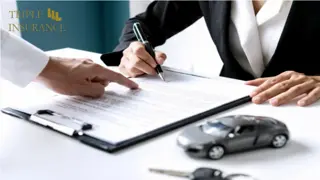The Evolving Role of AI in Insurance
Delve into the historical roots of actuarial science, the role of data and AI in modern insurance practices, and the impact of emerging technologies on the industry's future. Explore the convergence of artificial intelligence, machine learning, and data science in shaping the landscape of insurance operations and learn about key players and job trends in this evolving sector.
Download Presentation

Please find below an Image/Link to download the presentation.
The content on the website is provided AS IS for your information and personal use only. It may not be sold, licensed, or shared on other websites without obtaining consent from the author. Download presentation by click this link. If you encounter any issues during the download, it is possible that the publisher has removed the file from their server.
E N D
Presentation Transcript
The Evolving Role of AI in Insurance A look into the Past, Present, and Future of Technology in the industry Michael Kelch Sam Heil Adam Ramos 3/28/19
Outline Past The First Actuary Definitions Present Current Technology Trends Future Impacts How to prepare Regulations 1
The First Actuary One of first known insurance contracts 14th century First life table created Early 17th century First life premiums calculated scientifically 1762 Models introduced and computers begin to revolutionize the industry Mid 20th century Actuaries in practice use a variety of tables, models, and theory. All made more efficient with growing technology Current day 2
Data Science vs Actuarial Science Both professions use data to make informed decisions about the future. Actuaries are essentially data scientists with extensive insurance knowledge. With the growing usage of many programming languages, it is essential for the actuarial profession to broaden its skillset. Examples of growing languages include: R, Python, C++, SAS, among many others 3
Artificial Intelligence vs Machine Learning Artificial Intelligence Machine Learning The science of training machines to perform tasks. Any program that seeks to imitate human intelligence. Can range from as simple as if-then statements to a complex statistical software. Machine Learning is a subset of AI that trains a machine how to learn. Looks for patterns in data and draws conclusions. Uses a cycle of analyzing data to refine algorithms 4
AI Insurance Companies Brolly Lemonade Spixii.ai 5
How many jobs are at risk (in US)? Claims adjusters 125,000 Insurance agents 1.1 million Underwriters 6
AI and other Technology Present in Insurance Today Liberty Mutual immediate response claim cost estimates OnStar Automatic Crash Response Allstate s ABIe State Farm s Distracted Driver Competition Progressive s Snapshot 14 billion miles of driving data Wearables (Apple, Fitbit, Xiaomi) DriveCam by Lytx Existing tech affecting insurance every day Computing Power and Big Data Phone and Surveillance Cameras Social media 7
Trends Deteriorating Loss Ratios https://www.iii.org/sites/default/files/docs/pdf/auto_rates_wp_092716-62.pdf 8
Trends Rising Frequency https://www.iii.org/sites/default/files/docs/pdf/auto_rates_wp_092716-62.pdf 9
Trends Rising Severity https://www.iii.org/sites/default/files/docs/pdf/auto_rates_wp_092716-62.pdf 10
Trends - Summary StateFarm 18% underwriting loss in personal auto in 2016 Raise in frequency More Jobs = More Driving Cheaper Gas = More Driving Distracted Driving Higher claim costs More expensive parts Spike in traffic fatalities 11
Insurance Pricing of the Future Insurance companies are moving from proxy data (categorical data) to source data (about individuals) UBI is one main tool companies use to personalize pricing. Companies with systems in place to handle vast amounts of sensor data will be best positioned in the marketplace. Examples of sensors currently used include: Wearable technology Sensors on personal and commercial vehicles evaluating safety Smart home appliances 12
Impacts of AI in the Future AI can and will continue to help insurance companies. Automated Claim Support Allow for instant communication, saving customers and insurance companies time and money. Cuts out human errors, and prevents fraud through machine learning algorithms. Damage Assessment Machine learning bots can read images and evaluate severity. Predictive Analytics Health insurance companies are providing rewards enticing customers to remain healthy. 13
Impacts of AI in the Future (ctd.) Customer Segmentation Each customer wants something specific out of their insurance. Classifying customers by their needs allows for better customer satisfaction. Predicting Customer Lifetime Value (CLV) As AI continues to improve, insurance companies will be better able to predict customer behavior, such as retention, based off of customer behavior and attitude. Marketing Insurers can use AI to evaluate which customers to target, using the most effective techniques, such as special days of the year. Marketing can also be personalized, matching customer lifestyle. 14
How insurers can prepare for the future Focus on improving their AI technologies in every area where data is available. Develop a long-term plan to implement AI Requires investment of money and other resources, but it is essential to stay current with the market. Organize a system to handle vast amounts of source data Due to UBI technologies, source data can give customer specific information. Stay flexible Hiring talent that can adapt to changes in technology. Evolving regulation challenges often require unique solutions. 15
AI Regulation Changes Due to greater use of personalized data, regulations could restrict types of data collected via UBI sensors. Rate changes based on personalized data can be difficult to pass through regulation. Companies like Progressive have used tactics to workaround regulations. Customer privacy is a challenge for insurers that want more customer data. 16
Questions to Ponder WC insurance: What if robots take over upwards of 90% of manual labor jobs Auto insurance: Once regulation is passed, will automobiles be fully automated? How will premiums be effected? What if an automated car crashes and kills someone. Who is at fault? How will regulations transition? Will AI have the ability to fully take over jobs from claims adjusters, underwriters or actuaries? 17
Thank You for Your Attention Michael Kelch MKelch@PinnacleActuaries.com Adam Ramos ARamos@PinnacleActuaries.com Sam Heil SJHeil@ilstu.edu Commitment Beyond Numbers 18























